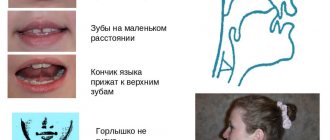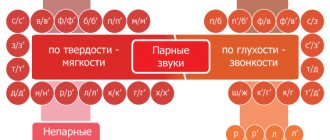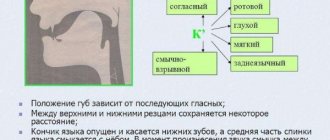general information
Parents may not always correctly notice distorted pronunciation. It is formed for various reasons. Most often the problem is in the short hypoglossal ligament. It attaches the tongue to the oral cavity and if it is not long enough, the mobility of the organ is limited.
The following congenital anatomical features may also be observed:
- high sky;
- narrow sky;
- massive tongue.
Sometimes replacing the front milk teeth with molars can take a long time and this will lead to incorrect pronunciation. Somatically weakened children who often suffer from colds may experience weak breathing and lethargy. Their tongue will move and rise poorly. Due to the lack of a strong air stream, it will not be possible to cause vibration.
Another reason for throaty pronunciation is early learning of a foreign language.
Some parents, from the age of three, begin to teach their child French or English, without taking into account the difference between the pronunciation of sounds.
Correcting such a defect will take a lot of time. It's easier to add sound when it is completely absent from speech. If it is pronounced distortedly, then you will have to make a lot of effort to correct the situation.
Throat pronunciation is difficult to correct due to insufficient development of phonetic-phonemic perception. The child gets used to hearing the defective sound and cannot distinguish it from the normal one. Therefore, attempts to introduce the correct sound into speech may end in failure.
Important points
Before you start working on sound correction, you need to consider some nuances. A thorough diagnosis is required. Some parents may only notice problems with the pronunciation of "R" but not the rest. Be sure to check:
- vocabulary;
- grammar;
- speech hearing.
The speech therapist also looks at the structure of the articulatory apparatus - lips, jaws, palate. During such a check, erased dysarthria can be detected. It is characterized by impaired muscle tone (they are too weak or too tense), weak breathing.
With dysarthria, the tongue may be bunched up in the mouth or lie completely limp against the teeth.
In this case, additional speech therapy massage and drug treatment will be required. Due to tone problems, problems with sound automation may occur.
Checking whether your pronunciation is throaty is quite simple. You need to ask to growl with your mouth open. If it really is in the throat, then the child will be able to do it.
Breathing exercises
In order to pronounce the sound “R”, a directed stream of air is required. Therefore, it is important to practice the child’s breathing, especially if he has difficulties with this process.
A home exercise routine may include the following tasks:
- "Candle". To complete the task you will need a regular candle that needs to be extinguished. You can simply blow hard on it so that the light immediately disappears, or blow long and slowly so that it squirms. At first, the distance between the mouth and the candle should be small, and then it should be gradually increased to make the activity more difficult.
- "Storm". You will need a glass of water and a juice straw. The baby should inhale air through his nose and exhale through his mouth through a straw. Thus, a small storm is formed, causing the water to actively move.
- "Snowflake". The child should open his mouth, stretching his lips in a smile, and place his tongue on the lower lip. Then you should put a small piece of paper on the tip of the tongue and invite the baby to blow it off.
Each exercise should be performed no more than 4 times. In this case, inhalation should always go through the nose, and exhale through the mouth. It is also important that the child does not have any health problems, that is, there is no sore throat, no unusual coating on the tongue, and so on.
Preparation of the articulatory apparatus
Before you learn how to make a sound and start performing speech therapy exercises on the sound “R”, it is necessary to prepare the muscle tissue of the speech organs so that they can work at full strength. Articulation gymnastics is used for this purpose. The following exercises can be used:
"Crap". The baby needs to smile, open his mouth slightly, then put his tongue on his lower lip and hold it in this position for several seconds. You need to start with 3 seconds, gradually increasing the time, but the result should be no more than 10 seconds.
“Punish the tongue.” To do this, you also need to position the speech organs, but no longer hold the tongue, but slap it with your upper lip, while pronouncing “Pya.”
"Jam". This exercise is performed as follows: open your mouth slightly, and then move your tongue along your upper lip from side to side. You can actually put a little something sweet on your lip so that your child is more willing to do gymnastics.
"Painter". The baby doesn’t have to open his mouth, but simply move his tongue across the palate, as if painting it. This is a good way to practice moving your tongue back and forth.
"Mushroom". The child will need to open his mouth slightly, smile, and completely “glue” his tongue to the roof of his mouth. Hold your tongue in this position for several seconds.
All of the above exercises for making the sound “P” must be performed before each lesson. They are indispensable in preparing the speech organs for basic training.
Methods of causing sound
After the preparatory stage has been worked out and the children can do everything well, they move directly to sound production. When pronunciating in the throat, it is advisable to achieve a proto (non-vibrating) “R” sound.
In front of the mirror, the child is asked to smile broadly, raise the tip of his tongue to the desired position and pronounce the sound “Z”. It will sound distorted and this is called a “broken bell”. Vowels are added to it and you get a growl, but without vibration.
The resulting sound can be immediately automated into syllables.
It is necessary that the child hears the difference in pronunciation well and can control himself.
You can try to create vibration. To do this, take a special probe (a stick with a small ball) and swing the tongue during pronunciation. With regular exercise, there will be no need for mechanical assistance.
Sometimes it is effective to use the machine gun exercise. The tip of the tongue hits the tubercles and is accompanied by the pronunciation of the sound “D”. Gradually, the movements speed up and with a strong exhalation, the desired rumble is heard. To facilitate perception, the combination “DR” or “TR” is introduced. Vowels are added to them and this combination is automated.









